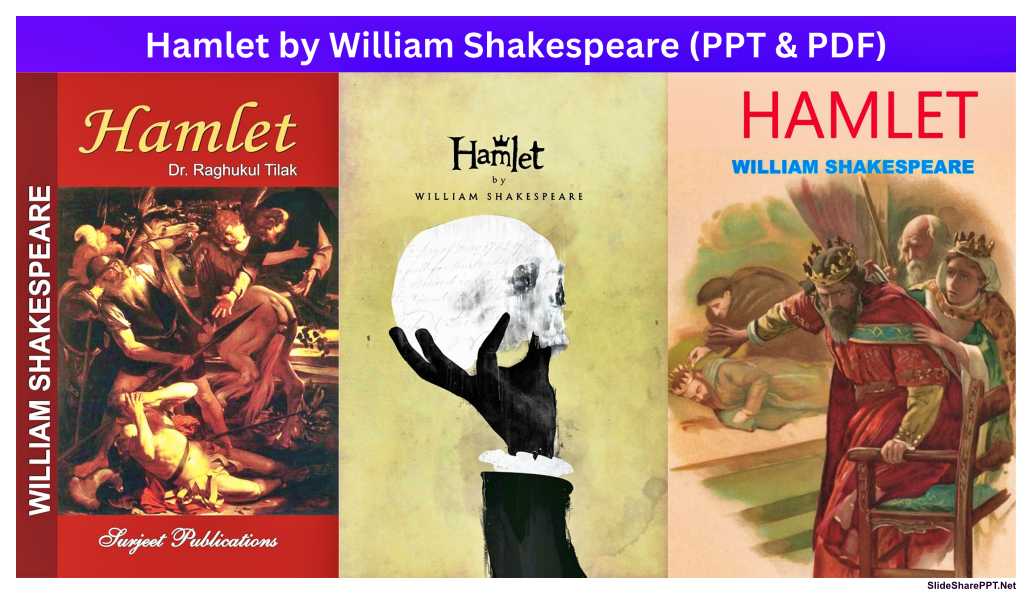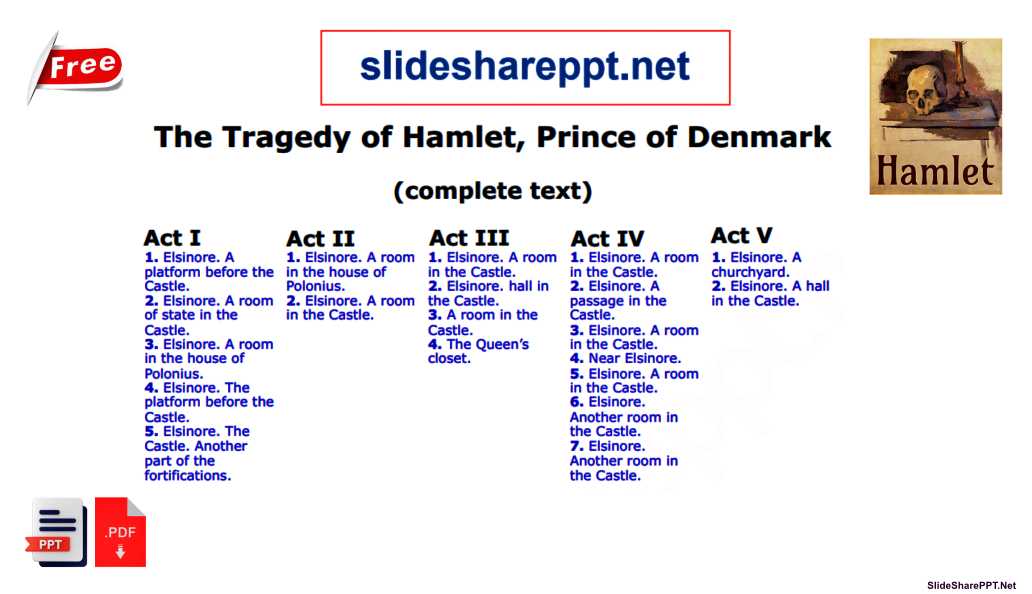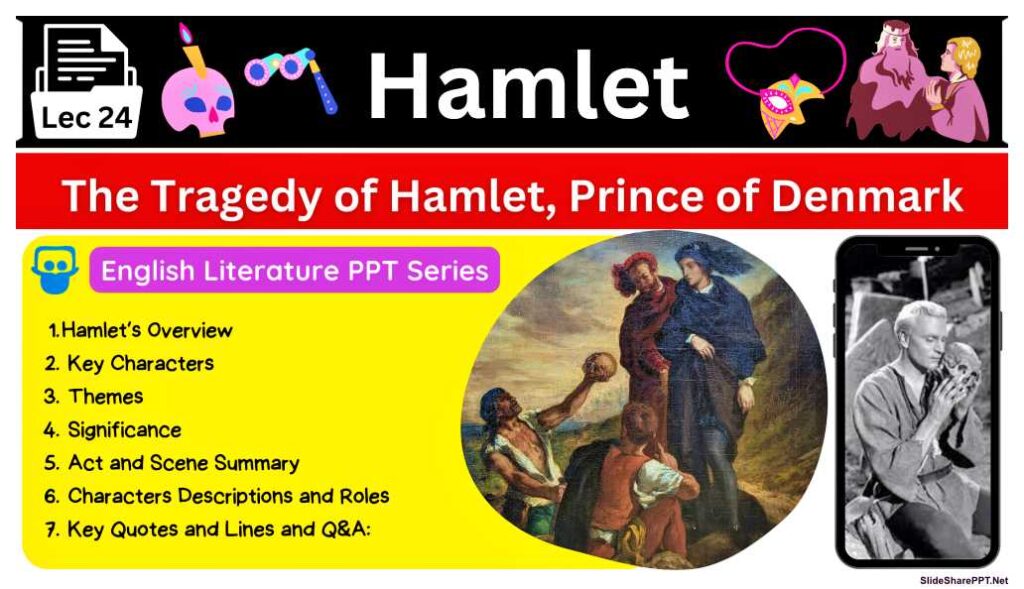Hamlet PPT Slides & PDF Download
Contents
Today we have shared the Notes of William Shakespeare’s Famous Play The Tragedy of Hamlet, Prince of Denmark, Hamlet PPT Slides & PDF Download, So as we know “Hamlet,” one of William Shakespeare’s most renowned tragedies, is a timeless masterpiece that has captivated audiences for centuries. Filled with complex characters, intricate plots, and profound themes, this play continues to resonate with audiences worldwide. In this complete guide, we delve into the plot, characters, themes, significance, and much more, shedding light on the enduring brilliance of “Hamlet.”
About Hamlet
Here’s a complete table for “Hamlet”:
| Aspect | Description |
|---|---|
| Title | Hamlet |
| Playwright | William Shakespeare |
| Genre | Tragedy, revenge tragedy |
| Date of Composition | Estimated to be between 1599 and 1601 |
| Setting | Denmark |
| Main Characters | Hamlet, Claudius, Gertrude, Ophelia, Polonius, Horatio, Laertes, Rosencrantz and Guildenstern, Fortinbras, The Ghost of Hamlet’s Father |
| Plot Overview | The play follows Prince Hamlet of Denmark, who is consumed by grief and anger following his father’s death and his mother’s hasty remarriage to his uncle Claudius. Prompted by the ghost of his father, Hamlet seeks to avenge his father’s murder, leading to a series of tragic events, including betrayal, madness, and death. |
| Key Themes | Revenge and justice, madness and sanity, mortality and the afterlife, corruption and decay |
| Significance | “Hamlet” is one of Shakespeare’s most famous and influential tragedies, renowned for its complex characters, philosophical depth, and exploration of existential themes. It is often considered one of the greatest works of world literature. |
| Notable Lines | – “To be, or not to be: that is the question.” (Act 3, Scene 1) – “What a piece of work is a man! How noble in reason, how infinite in faculty! In form and moving how express and admirable! In action how like an angel, in apprehension how like a god!” (Act 2, Scene 2) – “The play’s the thing wherein I’ll catch the conscience of the king.” (Act 2, Scene 2) |
| Adaptations | “Hamlet” has been adapted into numerous stage productions, films, and television adaptations. Notable adaptations include Laurence Olivier’s film (1948), Kenneth Branagh’s film (1996), and various stage productions by renowned theater companies. |
This table provides a comprehensive overview of various aspects of “Hamlet,” including its background, plot, characters, themes, significance, notable lines, and adaptations.
Hamlet PPT Slides
(Lecture 24)
Important:-
- If you are viewing this PPT on your phone, please make it full screen and then view it. (Press: 3 dots in PPT, then Full Screen)
- If you have a problem while clicking on next, (Just tap) on the slide instead of clicking Next Botton.
- FOR A BETTER VIEW PRESS Ctrl + Shift + F ON A PC OR LAPTOP.
- Whatever is written in the PPT is different and whatever is written below is different.

Hamlet by William Shakespeare
“Hamlet,” one of William Shakespeare’s most celebrated tragedies, unfolds in the kingdom of Denmark, where the young Prince Hamlet is consumed by grief and rage over his father’s untimely death and his mother’s swift remarriage to his uncle, Claudius. The play delves into themes of revenge, madness, mortality, and the complexities of the human condition, presenting a compelling narrative rich in psychological depth and moral ambiguity.
- The play opens with the appearance of King Hamlet’s ghost, who reveals to his son, Prince Hamlet, that he was murdered by Claudius, his own brother. Enraged by this revelation, Hamlet vows to avenge his father’s death, setting in motion a series of events that lead to tragedy.
- As Hamlet grapples with his duty to seek revenge, he becomes increasingly isolated and tormented by his own indecision. He feigns madness to disguise his intentions, leading to a spiral of deception and intrigue within the Danish court. Along the way, he encounters a cast of characters who further complicate his mission, including his mother Gertrude, his love interest Ophelia, and his trusted friend Horatio.
- Meanwhile, Claudius, the new king, grows suspicious of Hamlet’s erratic behavior and plots to eliminate him. He enlists the help of Hamlet’s childhood friends, Rosencrantz and Guildenstern, to spy on him and uncover his motives. As tensions escalate, Hamlet stages a play within a play, hoping to provoke a guilty reaction from Claudius and confirm his complicity in King Hamlet’s murder.
- However, Hamlet’s quest for vengeance proves fraught with moral dilemmas and internal conflicts. He struggles with the weight of his own conscience, questioning the morality of his actions and the futility of seeking justice through violence. His indecision ultimately leads to a series of tragic misunderstandings and fatal consequences.
- The climax of the play occurs during a fencing match between Hamlet and Laertes, Ophelia’s brother, orchestrated by Claudius and Laertes to bring about Hamlet’s demise. In the chaos that ensues, Claudius’s treachery is exposed, leading to a fatal confrontation that claims the lives of Hamlet, Claudius, Gertrude, and Laertes.
- As the play concludes, Prince Fortinbras of Norway arrives to claim the throne of Denmark, marking the end of a tumultuous era and the beginning of a new chapter in the kingdom’s history.
- In its exploration of themes such as revenge, madness, and moral ambiguity, “Hamlet” remains a timeless masterpiece that continues to captivate audiences with its richly drawn characters, intricate plot, and profound insights into the human condition.
Conclusion:
- “Hamlet” remains a cornerstone of Western literature, offering a profound meditation on the human condition and the complexities of revenge, madness, and mortality. Through its enduring relevance and timeless appeal, “Hamlet” continues to captivate and provoke audiences, ensuring its place as one of the greatest works of English literature.
Key Characters
Here’s a comprehensive table detailing the key characters in William Shakespeare’s “Hamlet”:
| Character | Description |
|---|---|
| Hamlet | The Prince of Denmark and the protagonist of the play. Hamlet is a complex character torn between conflicting desires for revenge, justice, and existential contemplation. His introspective nature and indecision drive much of the plot. |
| Claudius | The antagonist of the play and King of Denmark. Claudius is Hamlet’s uncle, who murders his brother, King Hamlet, to usurp the throne and marry Queen Gertrude. His guilt and deceit drive the central conflict and contribute to the play’s tragic outcome. |
| Gertrude | Hamlet’s mother and Queen of Denmark. Gertrude’s hasty remarriage to Claudius following King Hamlet’s death complicates Hamlet’s feelings and adds tension to their relationship. Her actions raise questions about her loyalty, complicity, and moral integrity. |
| Ophelia | A young noblewoman and Hamlet’s love interest. Ophelia is manipulated by her father, Polonius, and brother, Laertes, leading to her descent into madness and eventual tragic demise. Her character serves as a symbol of innocence corrupted by the machinations of others. |
| Polonius | Ophelia’s father and Claudius’s chief counselor. Polonius is a conniving and manipulative figure who spies on Hamlet and conspires to advance his own interests. His meddling and deceit contribute to the unraveling of events in the play. |
| Horatio | Hamlet’s loyal friend and confidant. Horatio is a steadfast and rational presence amidst the turmoil of the Danish court. He serves as a voice of reason for Hamlet and plays a key role in the unfolding of events, including the revelation of Claudius’s guilt. |
| Laertes | Ophelia’s brother and son of Polonius. Laertes is a foil to Hamlet, driven by a desire for revenge following his father’s death. His actions mirror Hamlet’s quest for justice, leading to a tragic confrontation in the final act of the play. |
| The Ghost | The spirit of King Hamlet, who appears to Hamlet and reveals the truth about his murder at the hands of Claudius. The Ghost’s appearance sets the events of the play in motion and serves as a catalyst for Hamlet’s quest for revenge. |
| Rosencrantz | A former childhood friend of Hamlet, sent by Claudius and Gertrude to spy on him. Along with Guildenstern, Rosencrantz serves as a pawn in Claudius’s schemes to uncover Hamlet’s motives and allegiance. |
| Guildenstern | Another former childhood friend of Hamlet, sent by Claudius and Gertrude to spy on him. Like Rosencrantz, Guildenstern is manipulated by Claudius in an attempt to control Hamlet’s behavior and uncover his secrets. |
Themes
Here’s a comprehensive table detailing the key themes in William Shakespeare’s “Hamlet”:
| Theme | Description |
|---|---|
| Revenge | Revenge is a central theme in “Hamlet,” as the protagonist, Hamlet, seeks to avenge his father’s murder by his uncle, Claudius. The theme explores the moral complexities and consequences of seeking vengeance, as well as the cyclical nature of violence. |
| Madness | Madness pervades the play, with several characters exhibiting signs of mental instability or feigning insanity. The theme of madness serves to blur the lines between reality and illusion, adding layers of complexity to the characters and their motivations. |
| Death and Mortality | Death and mortality are recurring motifs in “Hamlet,” as characters grapple with the inevitability of death and the fleeting nature of life. The theme explores existential questions about the meaning of life and the afterlife, adding depth to the play’s philosophical undertones. |
| Corruption and Decay | “Hamlet” exposes the corruption and moral decay lurking beneath the surface of the Danish court. The theme of corruption highlights the insidious nature of power and ambition, as well as the erosion of moral integrity in the pursuit of self-interest. |
| Appearance vs. Reality | The theme of appearance versus reality permeates the play, as characters conceal their true intentions behind masks of deceit and illusion. “Hamlet” explores the discrepancy between outward appearances and inner truths, inviting audiences to question the nature of perception and truth. |
| Inaction vs. Action | Hamlet’s indecision and procrastination are central to the theme of inaction versus action. The play examines the consequences of Hamlet’s inability to act decisively, as well as the complexities of moral responsibility and the paralysis of analysis. |
| Family and Betrayal | “Hamlet” delves into the dynamics of familial relationships and the betrayal that festers within them. The theme of family and betrayal explores themes of loyalty, trust, and the destructive effects of familial discord on individuals and society. |
Significance
Here’s a comprehensive table outlining the significance of William Shakespeare’s “Hamlet”:
| Significance | Description |
|---|---|
| Literary Masterpiece | “Hamlet” is widely regarded as one of Shakespeare’s greatest literary achievements and one of the most influential works in Western literature. Its complex characters, intricate plot, and profound themes have captivated audiences for centuries, earning it a place among the greatest tragedies ever written. |
| Exploration of Human Nature | “Hamlet” delves into the depths of the human psyche, exploring themes of revenge, madness, mortality, and existential angst. Through its richly drawn characters and philosophical musings, the play offers profound insights into the complexities of human nature, inviting audiences to contemplate life’s deepest questions and the intricacies of the human condition. |
| Psychological Depth | The character of Hamlet is renowned for his psychological complexity, with his inner turmoil, introspection, and moral dilemmas captivating audiences and scholars alike. “Hamlet” pioneered the portrayal of complex, multidimensional characters in literature, laying the groundwork for future works to explore the depths of human psychology. |
| Influence on Drama and Literature | “Hamlet” has had a profound influence on the development of drama and literature, inspiring countless adaptations, interpretations, and artistic works across various media. Its themes, characters, and iconic lines have permeated popular culture and continue to resonate with audiences worldwide, making it one of the most enduring and influential works in the English language. |
| Exploration of Power and Corruption | The play exposes the corruption and moral decay lurking beneath the surface of the Danish court, highlighting the insidious nature of power and ambition. “Hamlet” explores themes of political intrigue, betrayal, and the erosion of moral integrity, offering a critique of the corrupting influence of power on individuals and society. |
| Philosophical Inquiry | “Hamlet” is replete with philosophical musings and existential questions about the nature of life, death, and the human condition. The play’s contemplation of mortality, the afterlife, and the meaning of existence has sparked scholarly debate and reflection, inspiring generations of thinkers to ponder life’s deepest mysteries. |
| Cultural Legacy | “Hamlet” continues to be celebrated and studied in academic circles, theaters, and classrooms around the world. Its enduring legacy extends beyond literature, influencing fields such as psychology, philosophy, and the arts. The play’s timeless themes and universal appeal ensure its place as a cornerstone of Western culture and a testament to Shakespeare’s enduring genius. |
Act and Scene Summary
Here’s a table summarizing each act and scene of William Shakespeare’s “Hamlet”:
| Act | Scene | Summary |
|---|---|---|
| 1 | 1 | The play opens with a ghostly apparition of King Hamlet appearing on the battlements of Elsinore Castle. Horatio, Bernardo, and Marcellus witness the ghost and speculate about its appearance. |
| 2 | Claudius, the new king, addresses the court and celebrates his recent marriage to Queen Gertrude. Hamlet is distraught over his father’s death and his mother’s hasty remarriage. Horatio informs Hamlet about the ghost’s appearance, prompting Hamlet to join them on the watch. | |
| 3 | Polonius sends his servant, Reynaldo, to spy on his son Laertes in Paris. Ophelia informs Polonius of Hamlet’s strange behavior, prompting Polonius to believe that Hamlet’s love for Ophelia is the cause. Polonius plans to inform Claudius and Gertrude about Hamlet’s erratic behavior. | |
| 2 | 1 | Polonius sends Reynaldo to spy on Laertes in Paris and instructs him to gather information about his son’s activities. Claudius and Gertrude ask Rosencrantz and Guildenstern to investigate the cause of Hamlet’s melancholy. The scene ends with Claudius expressing concern over Hamlet’s behavior. |
| 2 | Hamlet feigns madness while plotting to confirm Claudius’s guilt. He rejects Ophelia, further fueling Polonius’s suspicions about Hamlet’s madness. Rosencrantz and Guildenstern attempt to uncover the cause of Hamlet’s melancholy, but Hamlet remains evasive and cryptic in his responses. | |
| 3 | Hamlet delivers his famous “To be, or not to be” soliloquy, contemplating the nature of existence and the futility of life. He encounters Ophelia and delivers a harsh tirade against women, further convincing Polonius of Hamlet’s madness. Claudius and Polonius eavesdrop on Hamlet and Ophelia’s conversation. | |
| 3 | 1 | The players arrive at Elsinore, and Hamlet asks them to perform a play that mirrors the circumstances of King Hamlet’s murder. Hamlet hopes the play will elicit a guilty reaction from Claudius, confirming his involvement in the murder. Claudius becomes increasingly agitated during the performance. |
| 2 | Claudius leaves the performance abruptly, confirming Hamlet’s suspicions of his guilt. Rosencrantz and Guildenstern attempt to convince Hamlet to reveal the cause of his madness, but Hamlet remains evasive. Hamlet privately contemplates killing Claudius but decides to wait for a more opportune moment. | |
| 3 | Claudius prays for forgiveness, expressing remorse for his actions. Hamlet considers killing Claudius but hesitates, fearing that Claudius’s death while praying would send him to heaven. | |
| 4 | 1 | Claudius confronts Hamlet about Polonius’s murder and sends him to England, accompanied by Rosencrantz and Guildenstern. Gertrude informs Claudius of Ophelia’s madness and death. Laertes returns to Denmark, seeking revenge for his father’s death. |
| 2 | Hamlet encounters Fortinbras’s army on its way to Poland and is inspired by Fortinbras’s determination. Hamlet delivers a soliloquy reflecting on his own lack of action and resolve. | |
| 3 | Claudius devises a plan with Laertes to kill Hamlet during a fencing match. Gertrude informs Laertes of Ophelia’s death, leading to Laertes’s vow of revenge against Hamlet. Horatio receives a letter from Hamlet, informing him of his return to Denmark. | |
| 5 | 1 | Hamlet and Horatio encounter gravediggers in the graveyard, leading to Hamlet’s contemplation of mortality and the inevitability of death. Ophelia’s funeral procession arrives, and Laertes expresses his grief and desire for revenge. Hamlet reveals his true identity to Horatio and the gravediggers. |
| 2 | Hamlet and Laertes engage in a duel during which they exchange swords. Gertrude drinks from the poisoned cup intended for Hamlet and dies. Laertes is wounded by his own poisoned sword. Hamlet fatally wounds Claudius before succumbing to the poison. Horatio attempts to drink the poisoned cup but is stopped by Hamlet. The play ends with Fortinbras assuming control of Denmark. |
Key Quotes and Lines
Here’s a table featuring key quotes and lines from William Shakespeare’s “Hamlet”:
| Quote | Speaker | Context |
|---|---|---|
| “To be, or not to be: that is the question.” | Hamlet | Hamlet’s soliloquy in Act 3, Scene 1, where he contemplates the nature of existence and the existential dilemma of whether to endure the pains of life or end them. |
| “Something is rotten in the state of Denmark.” | Marcellus | Marcellus’s remark in Act 1, Scene 4, expressing his suspicion of foul play and corruption within the Danish court, foreshadowing the pervasive deceit and moral decay that unfolds throughout the play. |
| “The lady doth protest too much, methinks.” | Gertrude | Gertrude’s observation in Act 3, Scene 2, during the performance of “The Murder of Gonzago,” suggesting her skepticism of the Queen in the play’s exaggerated declarations of fidelity. |
| “Frailty, thy name is woman!” | Hamlet | Hamlet’s lament in Act 1, Scene 2, expressing his disillusionment with his mother, Gertrude, for her perceived weakness and betrayal in marrying Claudius so soon after King Hamlet’s death. |
| “Neither a borrower nor a lender be, For loan oft loses both itself and friend.” | Polonius | Polonius’s advice to his son Laertes in Act 1, Scene 3, cautioning against the dangers of borrowing and lending, and the potential strain it can place on relationships and personal integrity. |
| “This above all: to thine own self be true.” | Polonius | Polonius’s counsel to Laertes in Act 1, Scene 3, emphasizing the importance of authenticity and self-awareness as essential virtues for navigating life’s challenges with integrity and purpose. |
| “The play’s the thing wherein I’ll catch the conscience of the king.” | Hamlet | Hamlet’s plan in Act 2, Scene 2, to stage a play that mirrors the circumstances of King Hamlet’s murder, intending to provoke a guilty reaction from Claudius and confirm his involvement in the crime. |
| “There is nothing either good or bad, but thinking makes it so.” | Hamlet | Hamlet’s reflection in Act 2, Scene 2, during his conversation with Rosencrantz and Guildenstern, contemplating the subjective nature of perception and the power of the mind to shape one’s reality. |
| “The readiness is all.” | Hamlet | Hamlet’s realization in Act 5, Scene 2, before his duel with Laertes, acknowledging the inevitability of fate and the importance of being prepared to face whatever challenges may come. |
| “Good night, sweet prince, And flights of angels sing thee to thy rest!” | Horatio | Horatio’s farewell to Hamlet in Act 5, Scene 2, as he mourns the death of his friend and bids him a final farewell, expressing the hope that Hamlet will find peace and rest in death. |
These quotes and lines capture the essence of “Hamlet,” showcasing the play’s profound themes, complex characters, and timeless wisdom.
Q&A:
Q: Who is the protagonist of “Hamlet”?
A: The protagonist of “Hamlet” is Prince Hamlet, the young Prince of Denmark.
Q: What is the central conflict in “Hamlet”?
A: The central conflict in “Hamlet” revolves around Hamlet’s quest for revenge against his uncle Claudius, who has murdered Hamlet’s father, King Hamlet, and usurped the throne.
Q: What is the significance of the “To be, or not to be” soliloquy?
A: The “To be, or not to be” soliloquy is one of the most famous passages in English literature. In it, Hamlet reflects on the nature of existence and the human condition, contemplating the idea of life versus death and the suffering inherent in life.
Q: Who is Ophelia, and what role does she play in the play?
A: Ophelia is a young noblewoman and Hamlet’s love interest. She becomes entangled in the machinations of her father, Polonius, and her brother, Laertes, and ultimately descends into madness, leading to her tragic demise.
Q: What is the significance of the ghost in “Hamlet”?
A: The ghost of King Hamlet serves as a catalyst for the events of the play, appearing to Hamlet and revealing the truth about his murder by Claudius. The ghost’s appearance sets Hamlet on his quest for revenge and raises questions about justice, morality, and the supernatural.
Q: How does “Hamlet” explore the theme of madness?
A: “Hamlet” features several characters who exhibit signs of madness or feign insanity, including Hamlet himself, Ophelia, and Claudius. The theme of madness serves to highlight the blurred lines between reality and illusion, as well as the psychological complexities of the characters.
Q: What is the role of revenge in “Hamlet”?
A: Revenge is a central theme in “Hamlet,” as Hamlet seeks to avenge his father’s murder by Claudius. The play explores the moral complexities and consequences of seeking revenge, as well as the toll it takes on Hamlet and those around him.
Q: How does “Hamlet” end?
A: “Hamlet” ends with a dramatic confrontation during a fencing match, where Hamlet and Laertes are both fatally wounded by poisoned swords. Claudius is also killed, and the play concludes with Prince Fortinbras of Norway assuming control of Denmark.
Q: What is the central theme of Hamlet?
A: The central theme of Hamlet revolves around revenge, madness, mortality, and the complexity of human emotions and actions.
Q: Who is the ghost in Hamlet and what does it reveal?
A: The ghost in Hamlet is believed to be the spirit of King Hamlet, Prince Hamlet’s father. It reveals that he was murdered by his brother Claudius, who is now the king.
Q: Why does Hamlet delay in avenging his father’s death?
A: Hamlet delays in avenging his father’s death because he is conflicted about the morality of his actions, doubts the honesty of the ghost, and struggles with his own indecisiveness and melancholy.
Q: What is Ophelia’s role in Hamlet?
A: Ophelia is a young noblewoman and Hamlet’s love interest. Her character serves to highlight Hamlet’s descent into madness and to explore themes of innocence, love, and betrayal.
Q: What is the significance of the play within a play (The Mousetrap) in Hamlet?
A: The play within a play is used by Hamlet to test King Claudius’s guilt. The reaction of Claudius during the play reveals his guilt to Hamlet and solidifies Hamlet’s resolve to avenge his father.
Q: How does Hamlet’s relationship with his mother, Gertrude, evolve throughout the play?
A: Hamlet’s relationship with Gertrude becomes strained after his father’s death and her hasty marriage to Claudius. Hamlet accuses her of betrayal and feels betrayed by her actions.
Q: What is the significance of the graveyard scene in Hamlet?
A: The graveyard scene, where Hamlet encounters Yorick’s skull, symbolizes mortality, the inevitability of death, and Hamlet’s contemplation of the fleeting nature of life.
Q: How does Hamlet’s tragic flaw contribute to his downfall?
A: Hamlet’s tragic flaw, his indecisiveness and overthinking, leads to his downfall as it prevents him from taking decisive action against Claudius in a timely manner, resulting in tragic consequences for himself and others.
Q: What role does Fortinbras play in Hamlet?
A: Fortinbras serves as a foil to Hamlet, highlighting Hamlet’s inaction and indecisiveness by contrast with Fortinbras’s swift and decisive actions to reclaim lost territory.
Q: What is the final outcome of the play Hamlet?
A: In the final act of the play, Hamlet and several other characters meet their tragic ends. Hamlet is mortally wounded by Laertes with a poisoned sword, Gertrude dies from drinking poisoned wine, Laertes is killed by his own poisoned sword, and Claudius is killed by Hamlet. The play ends with the deaths of most major characters, leaving the throne open for Fortinbras to take over Denmark.

Note: The complete Text PDF Link is at the end of the PowerPoint slides (go to the last PPT Slide)
MCQ:
Who is the ghost in Shakespeare’s play “Hamlet”?
A) King Claudius
B) Queen Gertrude
C) Prince Hamlet
D) King Hamlet’s spirit
Answer: D) King Hamlet’s spirit
What is the central theme of “Hamlet”?
A) Ambition
B) Revenge
C) Love
D) Loyalty
Answer: B) Revenge
Why does Hamlet delay in avenging his father’s death?
A) He is afraid of King Claudius
B) He doubts the honesty of the ghost
C) He doesn’t care about his father’s death
D) He is waiting for permission from his mother
Answer: B) He doubts the honesty of the ghost
What is the significance of the play within a play (The Mousetrap) in “Hamlet”?
A) It is a comedy performed for entertainment
B) It reveals the guilt of King Claudius
C) It showcases Hamlet’s acting skills
D) It serves as a distraction from the main plot
Answer: B) It reveals the guilt of King Claudius
How does Hamlet’s relationship with Gertrude evolve throughout the play?
A) They become closer and reconcile completely
B) Hamlet becomes indifferent towards his mother
C) Their relationship becomes strained due to Hamlet’s suspicions
D) Gertrude remains a minor character with no significant impact
Answer: C) Their relationship becomes strained due to Hamlet’s suspicions
What role does Ophelia play in “Hamlet”?
A) Hamlet’s friend and confidante
B) Claudius’s spy
C) Laertes’s love interest
D) Hamlet’s love interest
Answer: D) Hamlet’s love interest
What is Hamlet’s tragic flaw in the play?
A) Indecisiveness
B) Overconfidence
C) Arrogance
D) Inflexibility
Answer: A) Indecisiveness
Who is Fortinbras, and what is his significance in “Hamlet”?
A) He is Hamlet’s best friend
B) He is a rival prince seeking revenge
C) He is a loyal servant to King Claudius
D) He is a Norwegian prince with political ambitions
Answer: D) He is a Norwegian prince with political ambitions
How does Hamlet die in the play?
A) He dies by drowning
B) He is stabbed with a poisoned sword
C) He is hanged
D) He dies of illness
Answer: B) He is stabbed with a poisoned sword
What is the final outcome of “Hamlet”?
A) Hamlet becomes the king of Denmark
B) Hamlet kills Claudius and takes his place
C) Hamlet dies, along with several other characters
D) Hamlet escapes Denmark and lives in exile
Answer: C) Hamlet dies, along with several other characters
Also read: As You Like It PPT Slides & PDF Download



